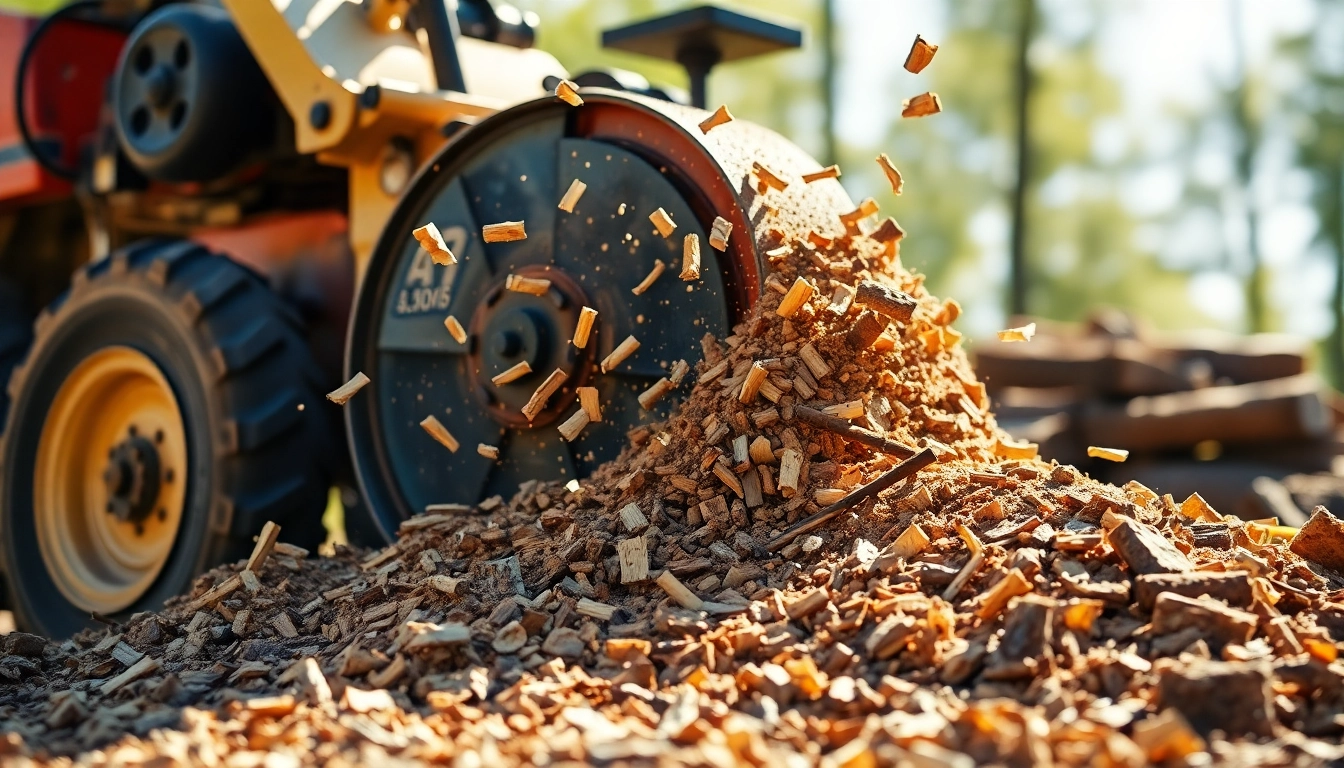Understanding Stump Grinding Service
When managing your property’s landscape, one of the most challenging tasks homeowners face is dealing with unwanted tree stumps. These remnants not only pose a tripping hazard but can also detract from the aesthetic appeal of your outdoor space. A professional stump grinding service is an effective solution to this problem. This article will explore what stump grinding is, its benefits, and how it compares to alternative methods.
What Is Stump Grinding?
Stump grinding is the process of mechanically removing tree stumps using a specialized machine known as a stump grinder. This machine grinds the stump into small wood chips, effectively eliminating the problem while leaving minimal disturbance to the surrounding area. The depth of grinding can vary based on the client’s needs and the size of the stump, allowing for a customized approach tailored to the landscape.
Benefits of Stump Grinding Service
Opting for stump grinding comes with several notable benefits:
- Improves Aesthetics: Removing stumps enhances the visual appeal of your yard or garden, allowing for more versatile landscaping options.
- Prevents Pest Infestation: Stumps can become a breeding ground for pests like termites, beetles, and fungi. Stump grinding mitigates this risk by eliminating the source.
- Increases Lawn Space: A stump can impede the growth of grass and other plants. Once removed, you have the option to plant grass, flowers, or even new trees.
- Reduces Safety Hazards: Stumps can pose tripping hazards for children and adults alike. Grinding them down removes this danger, making your landscape safer.
- Quicker Process: Compared to other methods like stump removal (which requires excavating roots), stump grinding is a faster option.
Stump Grinding vs. Alternatives
While stump grinding is a popular choice, it’s important to understand how it compares to other solutions, including stump removal and natural decomposition:
- Stump Removal: This involves digging out the entire stump and its roots, which can be labor-intensive, time-consuming, and potentially damaging to nearby structures. It is ideal for ensuring complete stump elimination but is significantly more invasive than stump grinding.
- Natural Decomposition: Allowing the stump to decay naturally is the least labor-intensive option, but it can take several years for the stump to fully decompose. In the meantime, the stump remains an aesthetic and safety issue.
Overall, stump grinding strikes a balance between immediacy and reduced landscape disruption, making it a preferred choice among homeowners.
Choosing the Right Stump Grinding Service
Selecting a qualified stump grinding service is crucial to ensuring the job is performed efficiently and safely. With numerous providers available, it’s essential to consider a few key factors before making your choice.
Factors to Consider When Hiring
Here are important factors to evaluate when choosing a stump grinding service:
- Experience and Reputation: Look for a company with a proven track record in stump grinding. Established companies usually have customer reviews and testimonials demonstrating their service quality.
- Insurance and Licensing: Ensure the service provider is licensed and insured to protect yourself from liability in case of accidents or damages during the job.
- Equipment Quality: Inquire about the equipment they use. Modern, well-maintained grinders can complete the job more effectively and with less disruption.
- Environmental Considerations: A responsible stump grinding service should be mindful of the environment, disposing of wood chips appropriately and minimizing damage to your landscape.
Questions to Ask Your Stump Grinding Service Provider
Before hiring a stump grinding service, it’s wise to ask targeted questions to gauge their expertise and suitability for your needs:
- How long have you been in business?
- Can you provide references or testimonials from past clients?
- What insurance do you carry?
- What type of equipment do you use for stump grinding?
- Do you offer any guarantees or warranties on your work?
- How do you handle the cleanup of wood chips after the grinding process?
Evaluating Customer Reviews and Testimonials
Customer reviews can provide invaluable insight into a stump grinding service’s reputation. Check various platforms, including social media and review websites, to understand client satisfaction levels and potential issues. Look for comments on responsiveness, quality of work, pricing, and whether the service upheld its promises. Positive testimonials are a good indication of a reliable service provider.
Stump Grinding Techniques and Equipment
A thorough understanding of the tools and techniques used in stump grinding can enhance the effectiveness and efficiency of the service. This section covers the essential equipment and best practices that experienced professionals follow.
Types of Stump Grinders
There are various types of stump grinders, each suited for different jobs:
- Walk-behind Stump Grinders: Ideal for residential jobs with smaller stumps, these grinders are easy to operate and can fit through narrow spaces.
- Vermeer Stump Grinders: These are versatile machines often used for larger stumps. Many modern versions come with advanced features for improved efficiency and safety.
- Tracked Stump Grinders: Equipped with tracks instead of wheels, these are designed for uneven terrain and can navigate challenging landscapes, making them suitable for more complex jobs.
- Remote-Controlled Stump Grinders: Offering enhanced safety, these machines can be operated from a distance, minimizing risks associated with nearby structures or personnel.
Best Practices for Stump Grinding
To ensure a successful stump grinding operation, professionals adhere to specific best practices:
- Assessment: Before grinding, assess the stump’s condition and the surrounding area to plan the necessary approach and equipment.
- Depth Considerations: Determine how deep to grind, considering future landscaping needs. Homeowners typically prefer a depth of 6-12 inches below ground level for better landscape integration.
- Clear Obstructions: Remove any rocks, debris, or other obstructions around the stump to avoid damaging equipment and ensure smoother grinding.
- Gradual Grinding: Operators should grind slowly and methodically, ensuring no portion of the stump remains above ground level.
Safety Measures during Stump Grinding Service
Safety is paramount during any stump grinding operation. Essential safety measures include:
- Personal Protective Equipment (PPE): Operators should wear safety goggles, gloves, hard hats, and hearing protection to minimize risks from debris and machinery noise.
- Site Safety Checks: Prior to starting, checking for underground utilities and overhead obstructions reduces the risk of accidents.
- Distance from Others: Maintaining a safe distance from bystanders ensures safety during the grinding process, as flying debris can cause injuries.
- Emergency Procedures: Having an emergency plan in place for accidents or machine failures ensures quick responses to any issues that may arise.
Costs and Pricing Factors for Stump Grinding
Understanding the cost structure for stump grinding services helps homeowners budget effectively. Various factors can influence the overall price of the service.
Average Costs of Stump Grinding Services
On average, stump grinding services can range from $75 to $1,000, depending on several factors related to the job’s complexity and scope. Pricing typically breaks down as follows:
- Small Stumps: Stumps under 12 inches in diameter usually cost between $75 and $150.
- Medium Stumps: Stumps between 12 and 24 inches range from $150 to $300.
- Large Stumps: Stumps over 24 inches can vary from $300 to $1,000, depending on access, labor, and equipment costs.
Factors Influencing Stump Grinding Pricing
Several factors can impact the final cost of stump grinding services, including:
- Location: Prices may vary based on geographic location, with urban areas typically resulting in higher service fees.
- Stump Size: Larger stumps require more time, effort, and specialized equipment, leading to increased costs.
- Accessibility: If the stump is located in a hard-to-reach area, additional fees may apply due to the extra effort required to maneuver equipment.
- Root System: The complexity and depth of the root system can influence grinding costs, particularly in cases with extensive root networks.
How to Get Quotes for Stump Grinding Services
Obtaining accurate quotes from multiple stump grinding services is vital for comparing costs and making informed decisions. Here’s how to approach this:
- Request Detailed Quotes: When reaching out to service providers, ask for itemized quotes that detail labor, equipment, and any additional fees.
- Schedule In-Person Assessments: Some companies may offer free assessments to provide accurate estimates based on site conditions.
- Check for Additional Services: Ask if they offer clean-up or landscaping services post-grinding, as bundling these can save costs.
Aftercare and Landscape Restoration Post Stump Grinding
After the stump grinding process, proper aftercare ensures your landscape remains aesthetically pleasing and functional. This section examines managing the remnants and enhancing your yard.
Managing the Residual Wood Chips
Following stump grinding, you will be left with wood chips that can either be a nuisance or a resource. Here are some options for managing them:
- Use as Mulch: The wood chips can be utilized as mulch for gardens, helping retain moisture, suppress weeds, and improve soil quality.
- Composting: If you have a compost pile, adding wood chips can contribute to a balanced carbon-to-nitrogen ratio, aiding the composting process.
- Disposal: If you prefer to dispose of the wood chips, inquire with your stump grinding service about disposal options. They may offer removal services or direct you to local disposal sites.
Landscaping Options after Stump Grinding
Once a stump is successfully ground down, the area can be transformed into a visually appealing part of your landscape. Consider these landscaping ideas:
- Replanting: Use the newly cleared space to plant grass, flowers, or even new shrubs or trees. Ensure the new plants are suited for the area and climate.
- Decorative Features: Consider adding decorative stones, a small rock garden, or an outdoor fountain to fill the space creatively.
- Patio or Pathway: Turn the area into a small patio or pathway with pavers or stones to create an inviting outdoor setting.
When to Consider Professional Help for Recovery
After stump grinding, you may require professional assistance to restore the landscape effectively. Consider hiring a landscaping professional if:
- You plan to undertake extensive landscaping changes.
- You are inexperienced with plant choices or garden design.
- You need help with site preparation or soil improvement.
Professional landscapers can offer valuable insights and execute plans effectively, ensuring successful landscape restoration.



